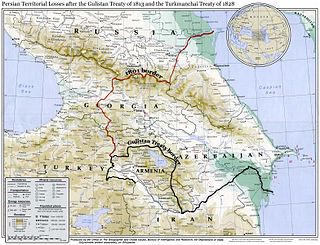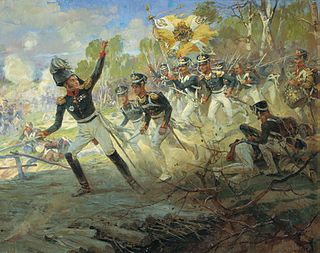Related Research Articles

Abbas Mirza was a Qajar crown prince of Iran. He developed a reputation as a military commander during the Russo-Persian War of 1804–1813 and the Russo-Persian War of 1826–1828, as well as through the Ottoman–Persian War of 1821–1823. He is furthermore noted as an early modernizer of Persia's armed forces and institutions, and for his death before his father, Fath Ali Shah.

The Aras is a river in the Caucasus. It rises in eastern Turkey and flows along the borders between Turkey and Armenia, between Turkey and the Nakhchivan exclave of Azerbaijan, between Iran and both Azerbaijan and Armenia, and, finally, through Azerbaijan where it flows into the Kura river. It drains the south side of the Lesser Caucasus Mountains while the Kura drains the north side of the Lesser Caucasus. The river's total length is 1,072 km (666 mi) and its watershed covers an area of 102,000 km2 (39,000 sq mi). The Aras is one of the longest rivers in the Caucasus.

The Treaty of Gulistan was a peace treaty concluded between the Russian Empire and Qajar Iran on 24 October 1813 in the village of Gulistan as a result of the first full-scale Russo-Persian War. The peace negotiations were precipitated by the successful storming of Lankaran by General Pyotr Kotlyarevsky on 1 January 1813. It was the first of a series of treaties signed between Qajar Iran and Imperial Russia that forced Persia to cede the territories that formerly were part of Iran.

Kakheti is a region (mkhare) formed in the 1990s in eastern Georgia from the historical province of Kakheti and the small, mountainous province of Tusheti. Telavi is its administrative center. The region comprises eight administrative districts: Telavi, Gurjaani, Qvareli, Sagarejo, Dedoplistsqaro, Signagi, Lagodekhi and Akhmeta.

The Russo-Turkish War of 1787–1792 involved an unsuccessful attempt by the Ottoman Empire to regain lands lost to the Russian Empire in the course of the previous Russo-Turkish War (1768–1774). It took place concomitantly with the Austro-Turkish War (1788–1791), Russo-Swedish War (1788–1790) and Theatre War.
The Russo-Persian Wars or Russo-Iranian Wars were a series of conflicts between 1651 and 1828, concerning Persia and the Russian Empire. Russia and Persia fought these wars over disputed governance of territories and countries in the Caucasus. The main territories disputed were Aran, Georgia and Armenia, as well as much of Dagestan – generally referred to as Transcaucasia – and considered part of the Safavid Iran prior to the Russo-Persian Wars. Over the course of the five Russo-Persian Wars, the governance of these regions transferred between the two empires. Between the Second and Third Russo-Persian Wars, there was an interbellum period in which a number of treaties were drawn up between the Russian and the Persian Empires, as well as between both parties and the Ottoman Empire. Ottoman interest in these territories further complicated the wars, with both sides forming alliances with the Ottoman Empire at different points throughout the wars. Following the Treaty of Turkmenchay, which concluded the Fifth Russo-Persian War, Persia ceded much of its Transcaucasian territory to the Russian Empire.

Russo-Turkish wars or Russo-Ottoman wars were a series of twelve wars fought between the Russian Empire and the Ottoman Empire between the 16th and 20th centuries. It was one of the longest series of military conflicts in European history. Except for the war of 1710–11, as well as the Crimean War which is often treated as a separate event, the conflicts ended disastrously for the Ottoman Empire, which was undergoing a long period of stagnation and decline; conversely, they showcased the ascendancy of Russia as a European power after the modernization efforts of Peter the Great in the early 18th century.

Western Armenia is a term to refer to the western parts of the Armenian highlands located within Turkey that comprise the historical homeland of the Armenians. Western Armenia, also referred to as Byzantine Armenia, emerged following the division of Greater Armenia between the Byzantine Empire and Sassanid Persia in AD 387. Since the Armenian genocide, the Armenian diaspora as well as Armenians indigenous to modern Turkey have sought political representation in Western Armenia or reunification with the Republic of Armenia.

The Russo-Persian War of 1722–1723, known in Russian historiography as the Persian campaign of Peter the Great, was a war between the Russian Empire and Safavid Iran, triggered by the tsar's attempt to expand Russian influence in the Caspian and Caucasus regions and to prevent its rival, the Ottoman Empire, from territorial gains in the region at the expense of declining Safavid Iran.

The Battle of Saltanovka, also known as the Battle of Mogilev, took place on 23 July 1812 during the early stages of the 1812 French invasion of Russia.
The Treaty of ConstantinopleRusso-Ottoman Treaty or Treaty of the Partition of Persia was a treaty concluded on 24 June 1724 between the Ottoman Empire and the Russian Empire, dividing large portions of the territory of mutually neighbouring Safavid Iran between them.

Diocese of Baku and Azerbaijan is a diocese of the Russian Orthodox Church in Azerbaijan. Majority of its members are ethnic Russians of Azerbaijan. Entire territory of Azerbaijan is under ecclesiastical jurisdiction of the Russian Orthodox Eparchy of Baku and Azerbaijan, centered in the Holy Myrrhbearers Cathedral in Baku. The Church of Michael Archangel also exist in Baku.

The Kingdom of Kartli was a late medieval/early modern monarchy in eastern Georgia, centred on the province of Kartli, with its capital at Tbilisi. It emerged in the process of a tripartite division of the Kingdom of Georgia in 1478 and existed, with several brief intervals, until 1762 when Kartli and the neighbouring Georgian kingdom of Kakheti were merged through dynastic succession under the Kakhetian branch of the Bagrationi dynasty. Through much of this period, the kingdom was a vassal of the successive dynasties of Iran, and to a much shorter period Ottoman Empire, but enjoyed intermittent periods of greater independence, especially after 1747.

The Derbent Khanate was a Caucasian khanate that was established in Afsharid Iran. It corresponded to southern Dagestan and its center was at Derbent.

The Battle of Kozludzha, fought on 20 June 1774 near the village of Kozludzha, was one of the final and decisive battles of the Russo-Turkish War (1768–1774). The Russians managed to rout the Ottoman army, scoring a major victory. This battle, alongside several others in this campaign, established the reputation of the Russian Lieutenant-General Alexander Suvorov as one of the brilliant commanders of his time.
The Treaty of Ganja was concluded between the Russian Empire and Safavids on 10 March 1735 during the Persian Siege of Ganja (1734) near the city of Ganja in present-day Azerbaijan. The treaty established a defensive alliance against the Ottoman Empire, which had suffered a defeat in the Ottoman–Persian War (1730–1735). The Russian government agreed to return the remaining territories in the North Caucasus and South Caucasus, including Derbend and Baku, that had been conquered by Peter the Great during the Russo-Persian War (1722–1723). The treaty also confirmed the provisions of the 1732 Treaty of Resht whereby Russia renounced its claim to Gilan, Mazandaran, and Astrabad, and Safavid state recognized Vakhtang VI, a pro-Russian Georgian king-in-exile. The treaty provided for Russia a diplomatic advantage in a simmering war with the Ottomans and for the Safavid ruler Nader Shah a respite on the western frontier of his empire.

Qajar Iran, also referred to as Qajar Persia, the Qajar Empire, Sublime State of Persia, officially the Sublime State of Iran and also known as the Guarded Domains of Iran, was an Iranian state ruled by the Qajar dynasty, which was of Turkic origin, specifically from the Qajar tribe, from 1789 to 1925. The Qajar family took full control of Iran in 1794, deposing Lotf 'Ali Khan, the last Shah of the Zand dynasty, and re-asserted Iranian sovereignty over large parts of the Caucasus. In 1796, Agha Mohammad Khan Qajar seized Mashhad with ease, putting an end to the Afsharid dynasty. He was formally crowned as Shah after his punitive campaign against Iran's Georgian subjects.
The Treaty of Saint Petersburg of 23 September [O.S. 12 September] 1723 concluded the Russo-Persian War of 1722-1723 between Imperial Russia and Safavid Iran. It ratified Iran's forced ceding of its territories in the North Caucasus, South Caucasus, and contemporary mainland Northern Iran, comprising Derbent (Dagestan), Baku, the respective surrounding lands of Shirvan, as well as the provinces of Gilan, Mazandaran, and Astarabad. The treaty further specified that the Iranian king would receive Russian troops for domestic peacekeeping.
Mostafa Khan was the last khan of Shirvan, until 1820.

Afsharid Iran, also referred as the Afsharid Empire, was an Iranian empire established by the Turkoman Afshar tribe in Iran's north-eastern province of Khorasan, establishing the Afsharid dynasty that would rule over Iran during the mid-eighteenth century. The dynasty's founder, Nader Shah, was a successful military commander who deposed the last member of the Safavid dynasty in 1736, and proclaimed himself Shah.
References
- ↑ Dowling, Timothy C. (2 December 2014). Russia at War: From the Mongol Conquest to Afghanistan, Chechnya, and Beyond ... Abc-Clio. ISBN 9781598849486 . Retrieved 25 December 2014.
- ↑ Mikaberidze, Alexander (2011). "Treaty of Resht (1732)". In Mikaberidze, Alexander (ed.). Conflict and Conquest in the Islamic World: A Historical Encyclopedia. ABC-CLIO. p. 346. ISBN 978-1598843361.
{{cite book}}: CS1 maint: location missing publisher (link) - ↑ Lang, David Marshall (1957). The Last Years of the Georgian Monarchy, 1658-1832. New York: Columbia University Press. p. 117.
- ↑ Dowling, Timothy C. (2 December 2014). Russia at War: From the Mongol Conquest to Afghanistan, Chechnya, and Beyond ... Abc-Clio. ISBN 9781598849486 . Retrieved 25 December 2014.